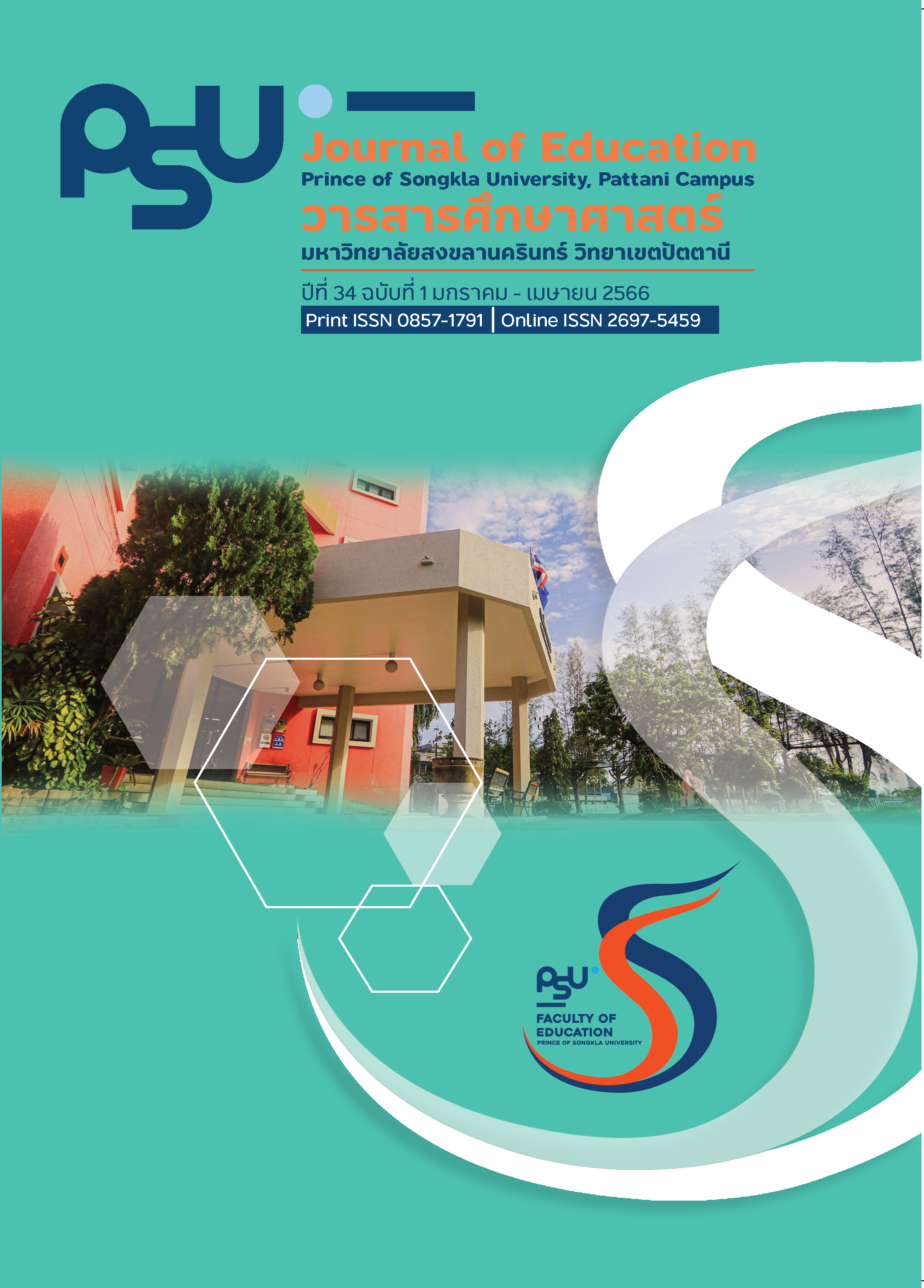การพัฒนาแบบวัดทักษะการคิดอย่างมีวิจารณญาณในศตวรรษที่ 21 ของนักเรียนชั้นมัธยมศึกษาตอนต้น โดยประยุกต์ใช้ทฤษฎีการตอบสนองข้อสอบแบบพหุวิภาค
Main Article Content
บทคัดย่อ
การวิจัยครั้งนี้มีวัตถุประสงค์เพื่อตรวจสอบคุณภาพแบบวัดทักษะการคิดอย่างมีวิจารณญาณในศตวรรษที่ 21 ของนักเรียนชั้นมัธยมศึกษาตอนต้นโดยประยุกต์ใช้ทฤษฎีการตอบสนองข้อสอบแบบพหุวิภาค ตัวอย่างที่ใช้ คือ นักเรียนชั้นมัธยมศึกษาตอนต้น ปีการศึกษา 2563 ในจังหวัดปัตตานี จำนวน 600 คน โดยวิธีการสุ่มตัวอย่างแบบแบ่งชั้น (Stratified Random Sampling) เครื่องมือในการวิจัย คือ แบบวัดทักษะการคิดอย่างมีวิจารณญาณในศตวรรษที่ 21 จำแนกเป็น 5 องค์ประกอบ ได้แก่ ทักษะการนิยามปัญหา ทักษะการรวบรวมข้อมูล ทักษะการวิเคราะห์ ทักษะการสังเคราะห์ และทักษะการประเมิน มีลักษณะเป็นข้อคำถามเชิงสถานการณ์ แบบเลือกตอบ 4 ตัวเลือก
จำนวน 36 ข้อ และมีลักษณะการตรวจให้คะแนนมากกว่า 2 ค่า โดยมีการให้คะแนนเป็นเกณฑ์รูบริค ตั้งแต่ ดีมาก (4) ดี (3) พอใช้ (2) และปรับปรุง (1) และวิเคราะห์ข้อมูลตามทฤษฎีการตอบสนองข้อสอบแบบพหุวิภาค (Polytomous IRT) โดยใช้ Graded Response Model ด้วยโปรแกรม MULTILOG
ผลการวิจัยพบว่า แบบวัดทักษะการคิดอย่างมีวิจารณญาณในศตวรรษที่ 21 มีคุณภาพตามทฤษฎีการตอบสนองข้อสอบแบบพหุวิภาค มีค่าพารามิเตอร์ความชันร่วม (α) มีค่าอยู่ระหว่าง 0.06 ถึง 1.72 ค่าความยาก (β) ของแต่ละรายการคำตอบ มีค่าเรียงลำดับจากน้อยไปมากทุกข้อ และการประมาณค่าความเที่ยง โดยวิธี Marginal Maximum-Likelihood (MML) มีค่าความเที่ยงเท่ากับ 0.885 สำหรับค่าฟังก์ชันสารสนเทศ ของการวิเคราะห์ข้อคำถามของแบบวัดทักษะการคิดอย่างมีวิจารณญาณในศตวรรษที่ 21 สามารถวิเคราะห์ข้อคำถามได้ถูกต้องแม่นยำในกลุ่มของผู้สอบที่มีความสามารถ (θ) อยู่ในช่วงระหว่าง -2.5 ถึง +0.5 หรือกลุ่มผู้สอบที่มีความสามารถต่ำถึงปานกลาง
Article Details

อนุญาตภายใต้เงื่อนไข Creative Commons Attribution-NonCommercial 4.0 International License.
เอกสารอ้างอิง
Berk, R.A. (1986). Determination of optimal cutting score in criterion-referenced measurement. Journal of Experimental Education, 45(2), 4-9.
Chianchana, C. (2009). Development of A Multidimensional Learning Strategies Scale for Upper Secondary School Students. Bangkok: Chulalongkorn University. [in Thai]
Christopher P., & Michael J. (2014). An integrated critical thinking framework for the 21st century. Journal of Thinking Skills and Creativity, 12(2014), 43-52.
Chuaytukpuan, T. (2013). A Development of Critical Thinking Process Test on Electricity for Students at Higher Education Level. Bangkok: Science Education Center Faculty of Science Srinakharinwirot University. [in Thai]
Creative Economy Agency. (2016). The magazine promotes creativity to drive the Thai economy. http//www.tcd.or.th/creativethailand/article/TheSubject/25279. [in Thai]
Decaroli, J. (1973). What Research Say to the Classroom Teacher: Critical Thinking. Social Education. 37 (January 1973).
Dressel, P.L., & Mayhew, L.B. (1957). General Education: Explorations in Evaluation. (2nd ed.). Washington, D.C. : American Council on Education.
Ennis, R.H. (1985). A logical basic for nursing critical thinking skills. Journal Creative Education, 4(6), 44-48.
Facione, P.A. (2000). The Disposition Toward Critical Thinking: Its Character, Measurement, and Relationship to Critical Thinking Skill. Informal Logic, 20(1), 61-84.
Hair, J.F., Black, W.C., Babin, B.J., Ander son, R.E., and Tatham, R.L. (2006). Multivariate Data Analysis. (6th ed.) New Jersey: Pearson Education.
Kanjanawasee, S. (2007). Modern Test Theories. (3rd ed). Bangkok: Chulalongkorn University Press. [in Thai]
Linda S. Behar-Horenstein. (2011). Teaching Critical Thinking Skills In Higher Education: A Review Of The Literature. Journal of College Teaching & Learning – February 2011, 2(8), 24-42.
Masae, P. (2018). Development of Measurement Scale on Media Literacy in the 21st Century for Lower Secondary School Student by Applying Polytomous Item Response Theory. Pattani: Prince of Songkla University. [in Thai]
Nekamanurak, P. (1994). The development of critical thinking developing model for teachers college students. Bangkok: Chulalongkorn University. [in Thai]
Noreen C. (1996). Externalizing the Critical Thinking in Knowledge Development and Clinical Judgment. San Francisco: California.
Nunnally, J.C., & Bernstein, I.H. (1994). The Assessment of Reliability. Journal of Psychometric Theory. 3(1), 248-292.
Office of the National Education Commission. (2006). Creative thinker: Educational management manual for who has a talent of high-level thinking skills. Bangkok: Ratanapornchai. [in Thai]
Office of the Education Council. (2018). State of Thai education in 2016/2017 Guidelines for reforming Thai education into the Thailand 4.0. Bangkok: Prikwarn Graphic CO.,LTD [in Thai]
Panich, V. (2012). Learning for learners in the 21st century. Bangkok: Sodsri-Saritwong Foundation. [in Thai]
Pattanaphon, O. (2008). A Construction of Critical Thinking Test for the third level Students in Secondary School, Nakornsawan Educational Service Area Office 1. Bangkok: Srinakharinwirot University. [in Thai]
Paul, R.W. (1984). Critical Thinking. Fundamental to Education for a Free Society Educational Leadership. Journal Educational Leadership, 42(1), 4-14.
Phettaweeporndech, K. (2014). A Study of Critical Thinking Components of Upper Secondary School Students. Journal of BU ACADEMIC REVIEW, 13(2), 95-108. [in Thai]
Quellmalz, Edys. Need. (1985). Better Methods for Testing Higher Order Thinking Skills. Education Leadership. https://www.semanticscholar.org
Sanrattana, V. (2013). 21st century just the beginning brighter education, brighter future let's start now. Bangkok: Thipwisut Press. [in Thai]
Sakonkitrungroj, S. (2015). Applying Iteme Response Model for Developing the Thai Happiness Scale: Computerized Adaptive Testindg. Chon Buri: Burapha University. [in Thai]
Sangong, S. (2012). Curriculum and Teaching of The 21st Century. Bangkok: Dhurakij Pundit University. [in Thai]
Staib, S., MS, RN. (2003). Teaching and Measuring Critical Thinking. Journal of Nursing Education, 11(42), 498-508.
Siriluk, W. (2014). Indicators Development of Student’s Skills in the 21st Century. Journal of Education Naresuan University, 16(4), 155-165. [in Thai]
Soodsane, D. (2018). Supplementary potential process about critical thinking of learners in the 21st century with consistent natural science. Bangkok: Office of the Basic Education Commission Ministry of Education. [in Thai]
Thongnak, S. (2013). Development of a Competency Test for Student Teachers Based on Teaching Professional Standards Using Polytomously Scored Item. Journal SDU Res. J, 9(1), 169-187. [in Thai]
Watson, G., & Glaser, E.M. (1964). Watson – Glaser Critical Thinking Appraisal Manual. New York: Harcourt, Brace and World.


